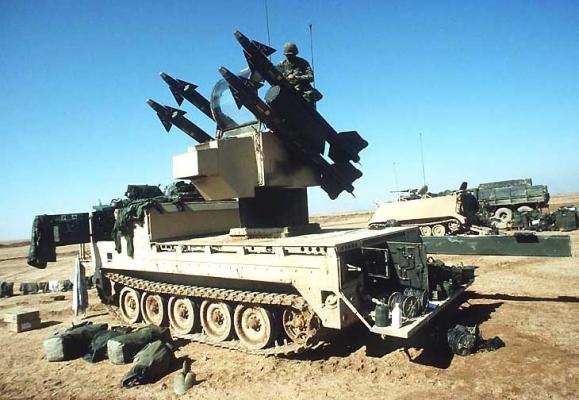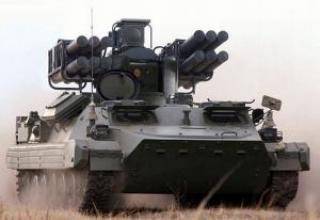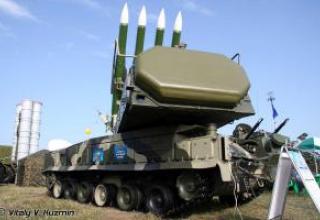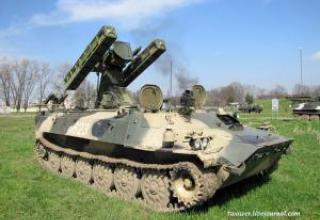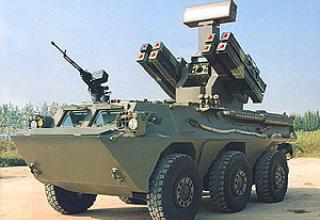Self-propelled all-weather anti-aircraft missile system "Chaparral" was developed by the American company "Lockheed Martin Aeronutronic". Creation of the complex began in 1964, adopted by the U.S. Army in 1969. The complex has been repeatedly upgraded.
In the early 90's in production were basic and advanced versions of the SAM system. The "Chaparral" complex of various modifications is in service with the armed forces of Egypt (50 SAM systems), Israel (52), Colombia (5), Morocco (37), Portugal (5), USA (523), Taiwan (45), Tunisia (26).
In combat conditions, the "Chaparral" SAM system was first used by the Israeli army in the Golan Heights, where it hit a MiG-17 aircraft in the last phase of the 1973 war, and in 1982 during the Israeli occupation of Lebanon - by Syrian aircraft.
Composition:
The standard configuration of Chaparral SAM system consists of two main elements: M730 tracked chassis, created on the basis of M548, and M54 launcher. The crew - 4 people: the commander of the department (in the course of the battle makes a selection of targets, their identification and determines the order of firing of the target), the senior shooter (works with the launcher and controls the station, and if necessary, replaces the commander), the driver (oversees the air situation and if necessary, acts as a radio operator) and the second (reserve) shooter, whose task - to find the target. If necessary, the crew allows to conduct combat work for 24 hours or more.
M730 chassis has a motor compartment and a compartment for combat calculation. Its seats are located at the front of the chassis on the sides. The chassis is equipped with a torsion suspension and a driver's infrared surveillance system. The chassis is amphibious, the tracks are used as a propulsion system on water. The launcher and control station, combined in the M54, consist of an engine with an electric generator, a space for storing missiles, the location of the crew and other necessary equipment, and the launch platform. The compartment for the senior gunner, located in the tower, is equipped with air conditioning and an adjustable seat. As with all army systems, the chassis is equipped with a filter-ventilation unit. The engine can be gasoline (M48 and M48A1) or diesel (M48A2 and M48AZ) and together with the generator they provide power to all equipment. At failure of the power unit combat work can be continued for a short time due to on-board batteries.
Information on the technical condition of the missile and the system is displayed on the control panel using switches and indicators, which allows you to control the preparation of systems of the complex, to select the missile to fire, determine the sequence of their launch, as well as to test the systems of the combat vehicle. Each missile launcher has its own system equipment.
Destroying the target in daylight hours is as follows. Target is notified by radar AN/MPQ-49 or by a visual observer. As soon as a target is detected, the shooter rotates the launch platform to get the target in the center of the sight or in the center of the field of view of the IR sights. The launch platform can rotate through 360° azimuth and -9° to +90° angle. After the target has been captured in the headphones, the shooter receives a tone signal (similar to when the target hits the infrared view area) and launches the missile. Proportional approach commands are generated by the tracking system and transmitted to the missile. The contact fuse ensures that the warhead is detonated without hitting the target directly. The use of the shot-forget principle in the missile allows, after firing at one target has been completed, to start searching for another, capture it and destroy it without waiting for the first target to be hit. The firing rate of the complex is 4 missiles per minute, with a full reload time of 5 minutes.
The "Chaparral" SAM is designed as a "duck", has two pairs of steering wheels located at the front of the missile, and four rigidly mounted wings - at the rear of two of which are symmetrically placed rollers to reduce the angular velocity of the roll. On the missile's launch guide is mounted with brackets rigidly mounted on the rocket motor housing. On the launcher there are four missiles in the ready state, eight more missiles - in ammunition. At present, several variants of Chaparral SAM have been developed. All versions of the missile have a single-stage solid propellant rocket engine. The signaling system under combat conditions has been reduced as a result of the use of a low-smoke engine in the latest versions of the missiles.
The basic version of the missile MIM-72A has a body diameter of 127 mm, length 2604 mm, wingspan-631 mm and a mass of 85 kg. The missile's combat unit (BW) weighing 11.2 kg is equipped with a diamond explosive substance (BB). MIM-72A missile has an effective range from 500m to 6000m (maximum range of the missile is 9300m with a flight duration of 22c). Its altitude range is from 15m to 3000m.
An improved version of the MIM-72C was developed in the period from 1970 to 1974. It entered the army in July 1978. The missile's dimensions remained the same, and its weight increased to 86.2 kg. The MIM-72C missile is equipped with the M250 fragmentation warhead with finished 12.6 kg tungsten alloy fragments developed at the Pikatinsky Arsenal, the M817 non-contact radio detonator developed by the Garry Diamond Laboratory, the AN/DAW-1 type IR GSN developed by Ford Aerospace and the Mk.36 low-smoke single-stage RDT. The effective range of the missile was over 9,000 m.
Later versions of this missile were designated as MIM-72E, MIM-72F and MIM-72G.
The MIM-72G version of the LRS is equipped with Ford Aerospace's Rosette Scan Seeker (RSS) infrared GSN AN/DAW-2, which provides an increased probability of target acquisition and earlier launch of the missile. Signal processing and interference control, both natural and artificial, in the new RSS is facilitated and accelerated by an integrated microprocessor. The Outdoor Scanning COS can be reprogrammed to respond to changing threat patterns, such as various thermal signatures, tracers and other infrared (IR) interference. It allows for electronic reprogramming via an external cable. The CLO provides a two-color spectral discrimination characteristic. This helps identify the target with infrared traps. According to the manufacturer's statement with SOS AN/DAW-2, the complex "Chaparral" has achieved actual insensitivity to infrared interference of all types. It was demonstrated that it is possible to capture the target at a distance 50% more than the range of the standard CNS. Flight tests were also successful, during which a direct hit of the helicopter at a range above 8 km was recorded. The M1M-72S rocket demonstrated the ability to capture automatic tracking of aerodynamic targets at a range of 16000 m and their destruction at a range of 9000 meters. It was confirmed that it is possible to intercept and destroy some types of tactical ballistic missiles during their capture for automatic tracking at ranges of about 22 km. MIM-72G SAM was put into service in 1987.
There is information about the development of a new SAM "Chaparral-2", equipped with a multi-mode guidance system, increased range (more than 15 km) and combat efficiency. The multi-mode guidance system will contain an IR search and tracking device, an acoustic sensor, a passive radio frequency sensor and a low intercept probability radar sensor. The Zoom will be immune to all known electronic and infrared countermeasures.
Characteristics:
| Maximum range for a helicopter-type target, m. | 500-8000 |
| Maximum range for an airplane type target, m | 500-9000 |
| Height of defeat, m | 1.5-3000 |
| The length of the rocket, m | 2.91 |
| The diameter of the rocket, m | 0.12 |
| Wingspan, m | 0.63 |
| Mass of the rocket, kg | 86.2 |
| Weight of combat unit, kg | 12.6 |
Testing:
The first combat use of the S-200 SAM system took place in 1982 in Syria, where at a distance of 190 km the E-2C "Hawkeye" DRLO was shot down, after which the American aircraft carrier fleet withdrew from the Lebanese coast. The Libyan S-200 complexes took part in repulsing an attack by American FB-111 bombers and possibly shot down one bomber.
On the basis of the 5B28 anti-aircraft missile of the S-200B complex a hypersonic flying laboratory "Cold" has been created to test hypersonic direct-flow air jet engines. The choice of this missile was based on the fact that the parameters of its flight path were close to those required for flight tests of the Hyper-Sonic Propulsion System. It was also considered important that the missile had been decommissioned and its cost was low. The missile's combat unit was replaced by the head compartments of the GLL "Kholod", which housed the flight control system, a liquid hydrogen tank with displacement system, a hydrogen flow control system with measuring devices and, finally, the experimental HPVRD E-57 of axially symmetric configuration.
Sources:
- Система ДОР. Сообщение 1188. Выпуск 7/90.(по зарубежной печати).
- Василин Н.Я., Гуринович А.Л. "Зенитные ракетные комплексы" .-Мн.: ООО "Попурри", 2002- 464с.


